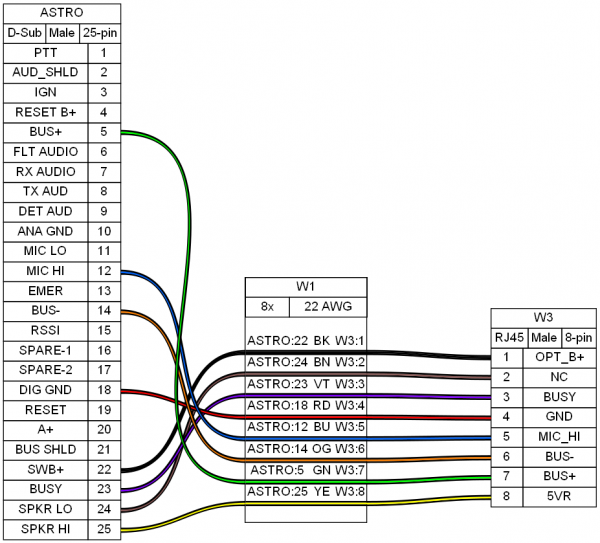Astro Spectra
The Astro Spectra is an Astro radio by Motorola which supports conventional analog and P25 operation as well as 3600-baud Type II trunking and, with the correct firmware, 9600-baud P25 trunking.
Features
Audio Enhancements
Analog and digital audio is processed by the audio DSP before it is sent through the RF section and transmitted. The default settings are fine, and most people will have no complaints with the quality of audio from these radios. However, as found through testing and tweaking by members of communications.support, there exists a much better setting for Astro radios that can make the transmitted audio from these units sound even better. These audio settings can be found in the Radio Configuration -> Radio-Wide -> Audio Gain Options section of CPS.
The settings are as follows:
- Analog: Checked
- Digital: Checked
- Type: AGC
- Output: 0
- Total: 6
Hardware
W3 Cable Connections
If you want to homebrew a W3 control head cable, the connections are as follows:
Note that inside the rubber boot of the W3 head is an RJ45 connector. Motorola is very inconsistent with their RJ45 pin numbering, but in this case pin 1 is the standard RJ45 pin 1 (far left with tab facing down).
Software
Available Flashcode Options
Out of Band
The Astro Spectra CPS can be easily modified to accept out-of-band frequencies using the Hex-Edit Method. However, the design of the Spectra VCO circuitry is such that large deviations from the designed frequency range are difficult. In practice, maximum out-of-band tuning can be limited to anywhere from 3 MHz all the way up to 10 MHz, varying from radio to radio. This can present a problem for amateur use, as the easiest bandsplit to use in the ham bands is the 450-482 MHz model. While some models will tune all the way to 440 MHz with no problem, others will experience VCO unlock at around 443 MHz, leaving the lower portion of the band unusable. Luckily, a simple hardware mod can resolve this issue.
VCO Resistor Mod
To allow the VCO PLL circuit to lock at the lower or higher amateur frequencies (depending on the bandsplit of the radio), a resistor must be placed from the negative VCO steering line to ground, or from the negative SL to the positive SL. This slightly lowers or raises the operating frequency range of the PLL and allows for tuning of the frequencies desired. A detailed walkthrough of the mod can be found at the RepeaterBuilder website. The value of this resistor can vary, and values from 100K all the way to 400K have been shown to work. Individual results will inevitably vary, but the general idea remains the same across both the Spectra and Astro Spectra lines - the VCO boards are the same for both platforms.
S-Records
Astro Spectra S-Records can be read and written with MTSXLab. The following are several S-records for various models of Astro Spectra that are confirmed working.
